The Complete Guide to Ideation
Many organizations don’t lack ideas, some big companies can have hundreds of ideas stuck somewhere in between ideators and decision makers. If getting new ideas is not the problem, why should organizations put additional effort into ideation?
Well, there’s actually a bit more to ideation than that. The problems arise when there’s too much focus on generating ideas and not enough on selecting the best ones and developing them further, both of which are essential parts of ideation done right. That way, ideation is rarely going to be a waste of time.
So, today we’ll help you avoid such mistakes and make ideation work for you. In this article we’ll dive deeper into what ideation is, how you can do it right and why it should be a systematic, holistic approach.
Table of contents
- What is ideation?
- Why is ideation important?
- Tools and techniques for ideation
- Idea challenge
- Brainstorm cards
- The impact-effort matrix
- Idea management tool
- The stage-gate process
- Storyboarding
- Analogy thinking
- Opposite thinking
- Key challenges
- Key success factors
- Align ideation with strategic goals
- Structured and methodical approach
- Ask the right questions
- Get the right people
- Express and test assumptions
- Love the problem, not the idea
- Remove barriers
- Use an ideation tool
- Conclusions
 What is ideation?
What is ideation?
We’ll start by clarifying the term ideation, as it’s been often mistakenly used interchangeably with terms like brainstorming and idea generation. While not far from the truth, these are simply parts of a more comprehensive process, which is ideation.
Ideation is the creative process of generating, developing, and communicating ideas. It’s important to note that these ideas don’t have to be completely new. You can ideate to solve specific problems, look into new ways of implementing a solution, or even collect feedback and evaluate ideas.
As you can see, ideation is not just a one-time idea generation or a brainstorming session. In fact, we can divide ideation in these three stages: generation, selection, and development. To paint a clearer picture, we’ve illustrated below the ideation process.
Ideation is not just a one-time idea generation or a brainstorming session
Ideation starts with idea generation, but the process itself has already started earlier, when you identified and defined the problem or opportunity. To facilitate the communication of ideas you can have various activities such as brainstorming sessions or idea challenges.
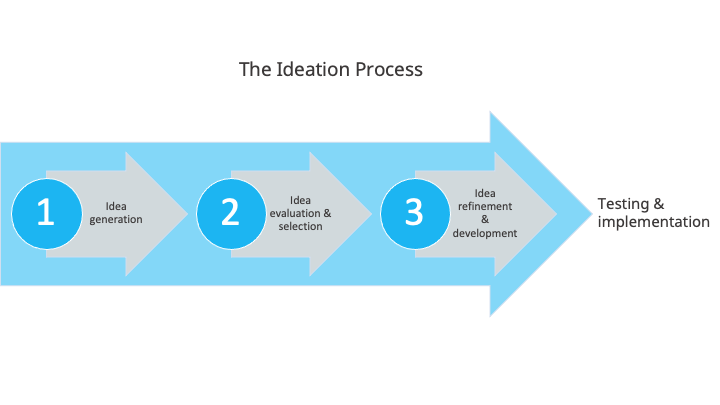
Unfortunately, for some, this is where ideation stops, and bottlenecks are created. In fact, ideation shouldn’t stop once you come up with ideas. They also have to be evaluated, refined, selected and developed. After all, what is an idea worth unless you can implement it and make it work?
Still, there is a better way to go around brainstorming sessions. Not all brainstorming has to end with ideas left of a whiteboard. We wrote an in-depth guide about efficient brainstorming session where we also provide practical steps on how to prepare and run such activities with Viima.
The important thing to remember is that both innovation and ideation should be present in the everyday work of your employees. You can see results when you persist and commit to these practices, but ideation alone won’t solve everything. Instead, you should make idea management a continuous practice and, on the way, use ideation to boost your results.
Even though they might have similarities, idea management is not the same as ideation. Ideation is more focused, linked to a specific problem or opportunity, while idea management is done at the level of the organization. This doesn’t make ideation less valuable, so let’s see why ideation is important for your organization.
Why is ideation important?
As mentioned earlier, ideas fuel innovation, they help improve products or services, they can drive new business and help you move forward.
While ideation is oftentimes discussed in the context of design thinking, we should mention that the benefits go beyond product development.
Ideation is useful to solve a wider variety of problems, and uncover opportunities that impact the entire organization. We should also look at ideation as more than a “suggestion box” and integrate it into an organization-wide plan.
But let’s narrow it down, and look at some very specific benefits of ideation:
- It can increase your innovation opportunities
Generally speaking, ideas are good when they have potential to turn into something that brings value for the organization and the customer. The good thing about ideation is that you can generate tons of ideas and when you have more, it means that you increase your chances of having more of the good ones.
As they say, the best way to get to the good ideas, is to have many ideas to choose from. Inevitably, you will have plenty of bad ones, but if you organize your ideation process to include evaluation and refining, you can sift through those with higher potential for innovative outcomes, and even if those would fail, you’ll still have a better idea of the challenges that are top-of-mind within your organization.
- Ideation can bring together different perspectives and ways of thinking
The purpose of your ideation and the expected outcome will influence the type of ideators you’ll bring together. As you will see later in this article, for best results, it’s good to involve diverse people, with different backgrounds and experiences in your ideation process.
What’s more, unlike a suggestion box, which can become chaotic and doesn’t allow for human interaction, through a more nuanced ideation process you give people the opportunity to exchange ideas in a transparent manner and build on each other’s ideas through feedback and evaluation.
When working on a specific problem or trying to come up with solutions or new ways of approaching an issue, we sometimes wear blinders. We think we can objectively look at the presented issue from all angles, but our knowledge or biases might prevent us from seeing things differently.
That’s why when we bring together diversity in terms of experiences and knowledge, we can look through a fresh lens and take advantage of new ways of thinking.
When we bring together diversity in terms of experiences and knowledge, we can look through a fresh lens.
If you bring together different people, teams, or departments you can go beyond the obvious solutions. Diversity in thought and knowledge can also reveal new areas of exploration, which takes us to the next benefit on the list.
- Develop and refine those into better ones
Effective ideation processes don’t have a purely spray and pray approach. While you can generate ideas and hope that one is the winner, and it sometimes works, that isn’t the approach most should rely on.
An ideation process that has been planned and prepared in advance to solve a specific challenge or to aim for a certain goal will help you challenge existing ideas and make it easier to select the most promising ones.
A good ideation process will give you the environment to develop and refine the best ideas. Obviously, some of those will require more time to be evaluated and refined. If, let’s say, you have different ideas on how to turn to more sustainable energy. Most good ideas will be quite complex and will need some close consideration to become better, before being passed to the next stage. And this is linked to the next point on our list.
- Helps you prioritize ideas and pick the most promising ones
Taking the above-mentioned example, many ideas around using sustainable energy will be very complex. A well-planned ideation process will help you prioritize these ideas and choose those that have the highest potential for implementation.
Evaluating ideas and choosing which ones to take further can become complicated, especially if you are dealing with more complex ideas. So, it’s important to find consistent criteria to evaluate and prioritize ideas.
- Encourage an open, innovative culture
Ironically, ideation is not just about the ideas. It’s also about the culture it nurtures in your organization. When people are encouraged to participate and speak their mind in a transparent manner, they will feel more connected to the cause, and will have a sense of belonging because they can actively contribute to the bottom line and their own ways of working.
Tools and techniques for ideation
Ideation is meant to find solutions, ideas, opportunities, all with the goal of bringing more innovation to the organization. However, there are many obstacles that can stay in the way of innovation and badly managed ideation can be one of them.
To prevent ideation from becoming a blocker in itself, you need to remove any unnecessary barriers from the process. For example, enable people to contribute with ideas whenever they feel inspired.
Most of us have that Eureka moment in the least expected moments and places. Even more, if you constrain your ideation process to a workshop or session, not only are more introverted people less likely to participate, but you also risk watering down good ideas into the average of the group and end up with a lukewarm compromise.
Ideation doesn’t have to be tied to an event or a space to occur and there are many tools and techniques that can help you create a better ideation process. Naturally, some small projects will benefit from a more focused activity like a brainstorming session, so in the end it all comes down to your goals and what you want to achieve.
For more clarity, we’ve listed below a number of tools and techniques you can use according to the ideation needs, whether they are related to idea generation, selection, or development.
1. Generation and communication
Brainstorming is the most popular method when mentioning ideation, but as it turns out, it can actually lead to less ideas.
Instead of jumping straight to brainstorming when you want to get more ideas around a specific topic, you should also look into other methods.
- Idea challenge
An idea challenge is a focused ideation method for finding creative solutions to specific problems, opportunities, or areas of improvement. In short, you decide on a question you want to address with a specific audience.
This topic is quite extensive and that’s why we also created a comprehensive toolkit for idea challenges. For the purpose of this article, we’ll summarize the basic concepts. So, idea challenges can be divided in two phases: problem and solution.
In the initial stage of ideation, you focus your idea challenge on the problem, by first discovering and defining it and then you continue with the solutions stage.
Idea challenges are a great way of gathering the entire organization around a strategic goal and get everyone’s creative input to find solutions to specific matters. However, keep in mind that it still needs some preparation work and resources to plan and execute it.
Idea challenges are a great way of gathering the entire organization around a strategic goal.
Also, if you believe your challenge needs the input of only a handful of professionals, like a small team that knows the topic very well, this might not be the best option for this situation. But there are many other idea generation tools you can choose from.
- Brainstorm cards
The brainstorm cards are a tool developed by Board of Innovation to help you generate plenty of new ideas for a challenge you might be working on. Used more like a game, the cards have 52 triggers to help you consider external factors such as societal trends, new technologies and regulations in your business.
A simple, fun way of coming up with ideas, best used in a brainstorming session where you can develop plenty of creative ideas. Make sure you give everyone some time alone to be creative, before you bring them together to discuss and develop their ideas.
2. Evaluation and selection
Every organization has more ideas than they can implement, so choosing which ones to work on is always important. If you’ve ever tried to decide between several ideas, you know it can get quite complicated, and at times even frustrating. It’s only natural, given the uncertainties and risks you have to deal with.
However, this is a crucial part if you really want to identify the ideas that are most likely to help you get you to your goals.
So, when you want to evaluate ideas, you should first consider that different types of ideas should be evaluated differently. An idea related to incremental improvements will be evaluated in a different, much more lightweight manner than a new idea for a business (disruptive ideas).
- The impact-effort matrix
Making the distinction between the types of ideas will guide your choices in the process, as well as the evaluation criteria.
For example, if you have to choose from different incremental improvement ideas, evaluate how well they fit with the current priorities, what is their business potential and what is the effort required for implementation.
This is mostly known as the impact-effort evaluation. You can use the impact-effort matrix to identify ideas that seem to be easier to implement while providing the most favourable impact for your organization.
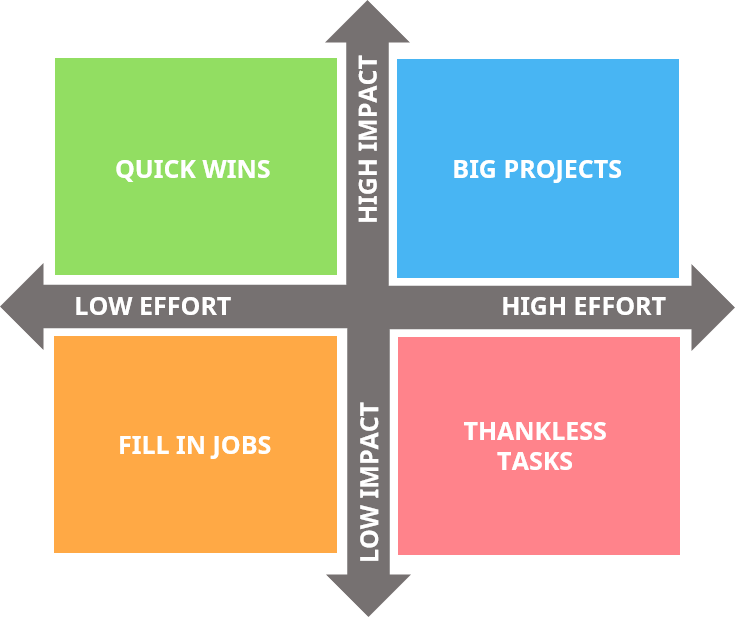
In the image above you can see the four quadrants. The first two are those that should be implemented first. In short, the lower the implementation effort and the higher the impact, the better.
This matrix can help you start your prioritization work and gives you the framework to make informed decisions. However, you should still treat ideas individually and consider that not all ideas can be prioritized using the same model. Sometimes you have to go the extra mile to find the criteria that fit your needs.
- Idea management tool
You have your methods of choosing which ideas to pursue, but how to manage all the information? The easiest, most transparent way to go about this, is to use an idea management tool. While there are other options out there, we believe Viima is still the best tool for the job. With Viima you can stay organized and automate many of the manual tasks, like calculating evaluation scores, comparing results, and transparency for all those involved in the process.
- The stage-gate process
The stage-gate process, also called the phase-gate process, is probably the most well-known process for selecting your ideas as it helps you reduce uncertainty. You can create a roadmap that helps you organize your process into smaller, manageable stages. It works best if you have an agreed set of standards as it can add clarity to processes that are a bit ambiguous.
The basic principle here is that you will always have more ideas than resources available.
 This model helps you ensure consistency among your ideas and eliminate those that are bad, or too similar. However, keep in mind that this works best in environments with highly predictable demand where you’re trying to address mostly technical challenges. If you are after the disruptive-type ideas, the stage-gate process is usually not the best solution.
This model helps you ensure consistency among your ideas and eliminate those that are bad, or too similar. However, keep in mind that this works best in environments with highly predictable demand where you’re trying to address mostly technical challenges. If you are after the disruptive-type ideas, the stage-gate process is usually not the best solution.
Note that when developing and evaluating ideas, you can’t always get it right from the comfort of your office. Sometimes you need to get out there to test your assumptions and figure out if the ideas are good or not, but also to understand how to make them better.
Sometimes you need to get out there to test your assumptions and figure out if the ideas are good or not, but also to understand how to make them better.
3. Refine and Develop
- Storyboarding
Another option that works for face-to-face sessions (but not only) is storyboarding. This is a tool that can help you explore existing ideas in a visual manner so you can have a better understanding of the connections between some of them.
You don’t need to draw a story per se, but rather just write down a sequence of events starting with your ideas. You can use this as research to gain more insights into those ideas that make more sense to consider for development.
- Analogy thinking
It’s highly unlikely that you will ever come up with a completely new idea that no one has ever thought about. After all, “new” ideas are a combination of already existing ideas.
Analogy thinking can help you put the pieces together. This tool is used to refine and develop ideas because you can take already existing information from one source and apply them to your problem.
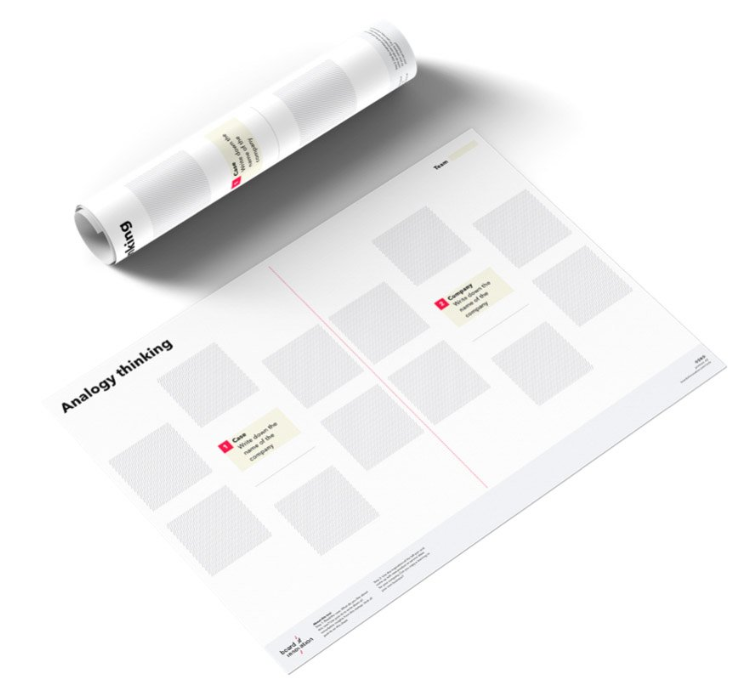
For example, apply analogy thinking to research other businesses in your market or industry and use that information to develop your ideas.
You don’t have to re-invent the wheel. The best solutions might already exist, you just need to work and adapt them for your case. You start with a simple analogy thinking canvas, on one side you add your researched companies and on the other, after you’ve brainstormed both individually and as a group, you add the ideas that were inspired by those successful businesses. The seven simple steps of this exercise are explained on Board of Innovation.
Keep in mind that analogy thinking is not just about a single tool, it’s also a mindset you can apply over and over again in your work. Embracing this concept systematically will open up new horizons.
- Opposite thinking
Another tool that can be used in the solution development phase of your ideation process is opposite thinking. It can be a little bit more complicated than the analogy thinking, but it’s a great way to give you a more structured approach on how to get to those out of the box ideas. The purpose is to make you question your long-held assumptions.
With this tool you can challenge your own thinking and broaden your horizons and find new, unexpected ways to develop a solution. For example, you start by listing your assumptions and then you come up with a negative statement that contradicts the assumption. This can be used even outside of your ideation process, as a method to change perspectives and see problems from different angles.
Key challenges for ideation
Before choosing any of these tools, you should also be aware of some of the challenges in doing ideation in practice. Such challenges can arise in any area of the ideation process. You can choose the best idea and develop it, but the delivery can still fail.
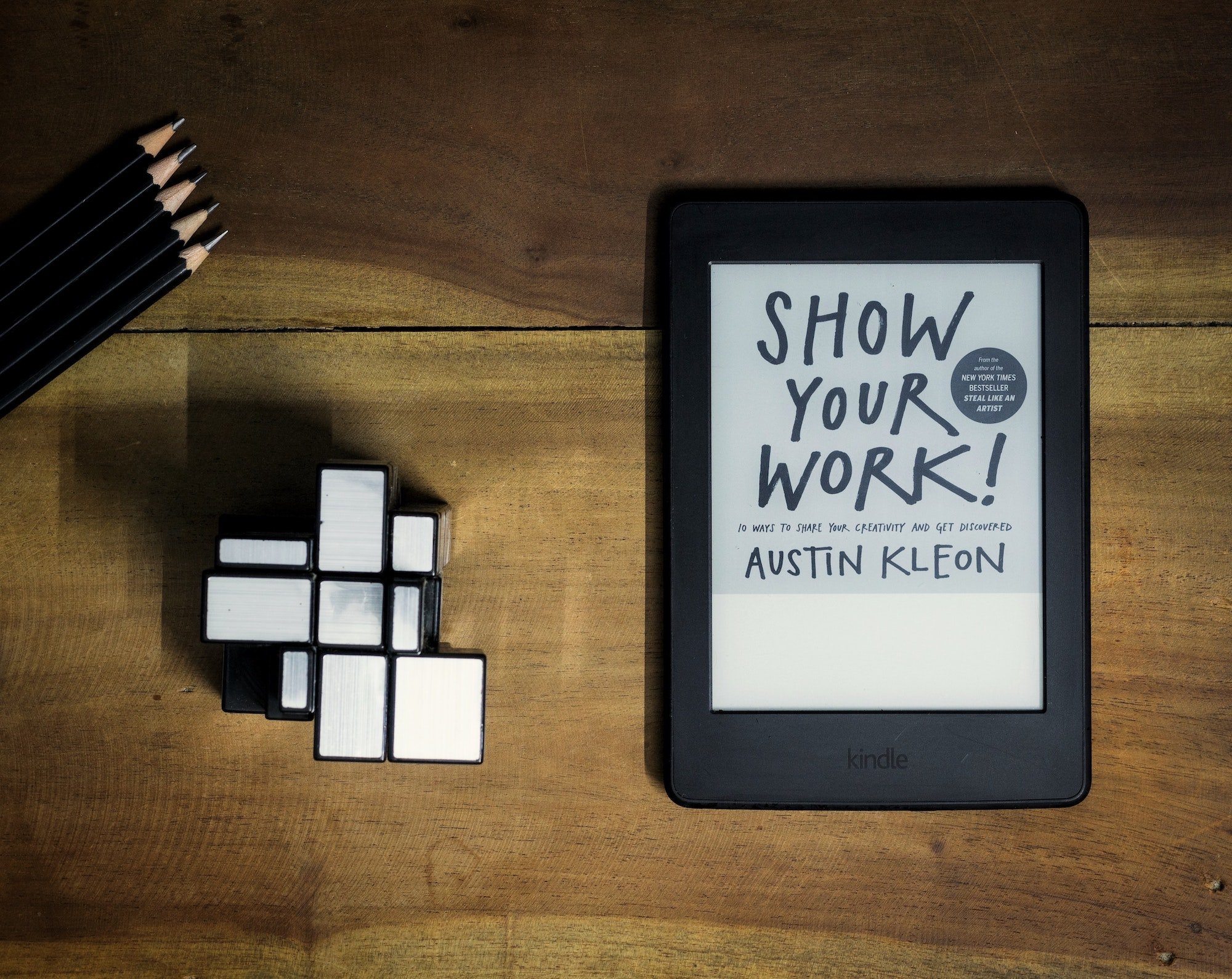 For example, the Sony Reader was the precursor of Amazon’s Kindle. They had a great product, but the execution failed. Some say Amazon came with a less performant version of the same idea, but they excelled at taking it to the market.
For example, the Sony Reader was the precursor of Amazon’s Kindle. They had a great product, but the execution failed. Some say Amazon came with a less performant version of the same idea, but they excelled at taking it to the market.
As you can see, there are many challenges ahead. So, let’s go through some of those that might not be so obvious, but can become setbacks in your ideation process, and how to go about them.
- “Functional fixedness”
Functional fixedness is a term generally describing the inability to realize that something with a specific function can be used with different functions as well. This kind of cognitive bias can affect our ability to think creatively and come up with new ideas.
To overcome this in the context of ideation, try asking questions like “why not” or “what if”. A great example of this is how Van Philips thought “why should prosthetic limbs look like human ones?”. This led him to create the C shaped blades for amputees. Observing animals and the mechanics of diving boards and pole vaulting, he didn’t focus on the bone structure, but on ligaments and tendons, and how they can be replicated.
Since the 1970s, prosthetics have come a long way and today, Paralympic athletes can even run faster than people with functional limbs. Of course, the evolution of such an innovative, complex product is more than an aha moment, but you get the point.
An important element that might have contributed to Van Philips’ success is that he looked for solutions to a problem that affected him too, having lost a leg in an accident. He was not a professional in the field, a doctor, or a surgeon so he had no previous experience that would block his creativity. And this takes us to our next point.
- “Déformation professionnelle”
This term borrowed from French is another cognitive bias that shows how expertise is not always a recipe for success. Just like in our previous example, sometimes those who come with the best ideas, aren’t necessarily experts in the field they innovate.
Of course, it’s not a bad thing to be an expert, but in certain contexts, like ideation, it can be limiting. We tend to see the world through the jobs that we have, so it’s easy to omit the new possibilities on the horizon.
That’s why it’s very important to bring the right people in your ideation process. And by “right” we don’t mean the best, most experienced in the field, but diverse people, who have different backgrounds, skills, and knowledge. For this, you need an open mind and to set aside the “this is how we do things here” thinking. This openness is also important for the experts in their field because they should be able to provide guidance and knowledge to refine and implement those ideas.
- It can be chaotic
Ideation is often associated with the group sessions, the post-its on the walls and the fun-looking events. While these can have their time and place, the outcome of such activities can be chaotic and messy, and a lot of good ideas are often lost in the process. Even if the activity is guided, ideas are written down and passed on, this workflow is still very limiting.
The problem here, is that there is no structured way of dealing with the ideas that were generated. People will soon become disengaged if ideas aren’t being moved forward, or if they don’t know the outcome of their contribution. As already mentioned, these workshops can work under certain circumstances, but if you want to maximize the chances to succeed with ideation, it’s best to use an ideation tool alone, or in combination with these methods.
With an ideation tool you can transparently share ideas, gather feedback, refine, evaluate, and further develop them. Instead of trying to re-invent the wheel, an ideation tool can dramatically increase knowledge sharing and allow people to keep on building on top of the existing one.
Key success factors for ideation
As you’ve probably figured out by now, coming up with an idea is not the hardest part in the process. Some of the greatest ideas had to wait for many years before implementation. For example, the idea of a mobile phone can be traced down to the early 1900s, but it took a lot of refinement, development, and other technologies to be invented before we had the first real mobile phone.
So, if you want to succeed with ideation, remember that it’s not just about having ideas, and collecting them in a drawer for later use. You’ll always have ideas that need to wait their turn, but if you create a well structured plan and gather them in the context of a project, chances are it will be easier to take them to completion.
And now that we’ve seen some of the major challenges of ideation, let’s see what you can do differently to increase your odds of success.
- Align ideation with strategic goals
No matter what kind of solutions and ideas you’re looking for, it’s essential to set a quantifiable goal for your ideation. The goal you choose should be easy to reach, but also ambitious enough.
Is this goal pursuing a long-term agenda or is it a one-time thing? How will ideas move forwards, who’s in charge and so on. This step will also give some clarity on the problem or opportunity you’re working to solve. A detailed plan that fits the strategic goals of the organization will make things easier along the way.
- Structured and methodical approach
Ideas alone can’t make innovation happen and individual innovation activities won’t bring long-term impactful results. You need a systematic approach to ideation, to make it part of the daily work. In fact, you should think of ideation as a mindset embedded in the culture of the organization.
Of course, building an innovation culture is a much more complex topic, but it’s something you need to strive towards. Train your mind, and your employees to think of ideation as a regular everyday activity, not something that happens at bi-annual off-sites.
Sometimes it’s perfectly fine to have one-time activities, but the structure and methodical aspects are still essential. You have to figure out how to turn raw ideas that are always bubbling on the surface, into something that can actually create value. For this, it’s important to allocate resources in advance and have a safety net prepared for implementing these ideas.
- Ask the right questions
By asking the right question you can transition from identifying the right problem to creating the solution. Of course, it’s easier said than done, but coming out with out of the box ideas has never been easy.

If you want to get the most of your ideation efforts, you should first get down to the core of the problem and break it into smaller, fundamental truths. This first principle thinking helps bringing focus and frames the problem better. Some of these questions are:
- What do we certainly know to be true?
- What is universally thought to be true but isn’t?
- What could be possible but currently is not for some reason?
- Has someone else solved a similar problem?
These will also help you question your assumptions and change perspective.
Furthermore, don’t be afraid to set the bar high. Instead of asking how we can make it 10% better, ask how to make it 10x better. Naturally, the higher the goal, the more constraints you’ll encounter. But this should not be a setback. Instead, it should force people to be more creative.
Without constraints people tend to come up with mediocre solutions or small improvement suggestions. But when you frame the problem better and you set clear, ambitious goals those constraints can become an advantage.
Without constraints people tend to come up with mediocre solutions or small improvement suggestions.
To ensure that everyone knows how to ask the right questions, train everyone in the organization to become a facilitator and to encourage this approach.
- Get the right people
For your ideation to be effective, it’s important to involve the right people in the process. For this, you need to consider relevance, size and reachability.
These three elements are pretty straight forward, and you should find the right balance between them. To simplify things, we can take a previously mentioned example. If you are looking for ideas and solutions on sustainable energy, this is a broad, complex topic.
So, you will first need experts to help you narrow it down, find the right focus and then work on it. However, if you have a less concrete topic that concerns many people in the organization, like how to reduce waste in the office, then you can reach a wider audience.
The idea is that the right people will depend on your goals and requirements and all these three factors will vary accordingly.
- Express and test assumptions behind the ideas
Even though you’ll probably focus mostly on collecting and evaluating the ideas, it doesn’t mean you can’t go wrong with your assumptions. You’ll never eliminate uncertainty completely, but to minimize it you should always test assumptions in the real world.
What’s more, you could end up with really bad ideas, even when the underlying problem they address is really important. Thus, you can get more value in articulating the problem, than in the ideas themselves. That’s why it’s essential to make it a habit for everyone involved in ideation to explicitly express the assumptions behind their idea.
- Love the problem, not the idea
Drawing from the famous quote “learn to fall in love with the problem, not the solution” we can extend the same thinking to ideas. As mentioned earlier, ideas often start with assumptions which unless tested, can lead you in the wrong direction.
So, falling in love with the problem, in this case is more about getting to the bottom of your problem because that’s how you can get the ideas that can bring value. And until you test those ideas, you won’t know if you are wrong or not. Commit to the problem, and ideas will follow.
- Remove barriers
Besides the goals you set for your ideation, in the end what you want to achieve is to implement some of the ideas you’ve generated. While idea implementation is the final stage of an idea’s journey and it’s left outside of the ideation process, you still need to prepare the ground and remove any barriers that can impede its completion.
As a first step, make it easy to share information, provide feedback and allow everyone to build on top of others’ ideas in a transparent manner. This can be achieved with the right processes and tools. However, along the way you will encounter other barriers that need your attention, such as bureaucracy and the lack of processes and tools. This takes us to the next point on the list.
- Use an ideation tool
Let’s face it, post-its and notes on a whiteboard won’t cut it anymore, especially in this day and age, when a lot of activities happen remotely. You need to go digital and idea management tools can help organize and enhance ideas, as well as keep track of the whole process.
There are plenty of idea management tools out there, some more useful than others. It’s up to you to choose what suits your needs. It’s crucial to have an effective process for managing ideas, not just for collecting them. The process will look different for each organization.
We’re obviously biased, but using Viima to set the process is a great way to get started. It’s completely free and it gets you going in just a few minutes.
Conclusion
To sum it up, we want to remind you that ideas are the starting point of every innovation and while having many ideas to choose from is great, what happens next is even more important. We might state the obvious here, but if you have no ideas, you have no innovation. However, if nothing happens with those ideas in terms of selection, development, and implementation, again, there is no innovation.
So, even though ideation might sometimes get a bad reputation, the problem is usually not with ideation per se, but with the lack of systematic processes to get from vague ideas to implemented solutions that serve the organization’s overall goals.
The point is to not get discouraged if you don’t see the results right away. Ideation has its limitations, but it’s a key part in the journey of innovation. Just make sure it doesn’t stop once you’ve captured the ideas.
That being said, commit to the process, take it step by step and systematically work towards implementing your ideas.
If you're working on your ideation process, whether you're just getting started or you're more advanced in the journey, idea challenges can always be useful.
So feel free to download our Idea Challenge Toolkit. The Toolkit consists of:
1. Slide templates for planning the process and communicating it
2. Email templates that further help you communicate the right points
3. A modifiable copy of the Idea Challenge Canvas for planning the challenge




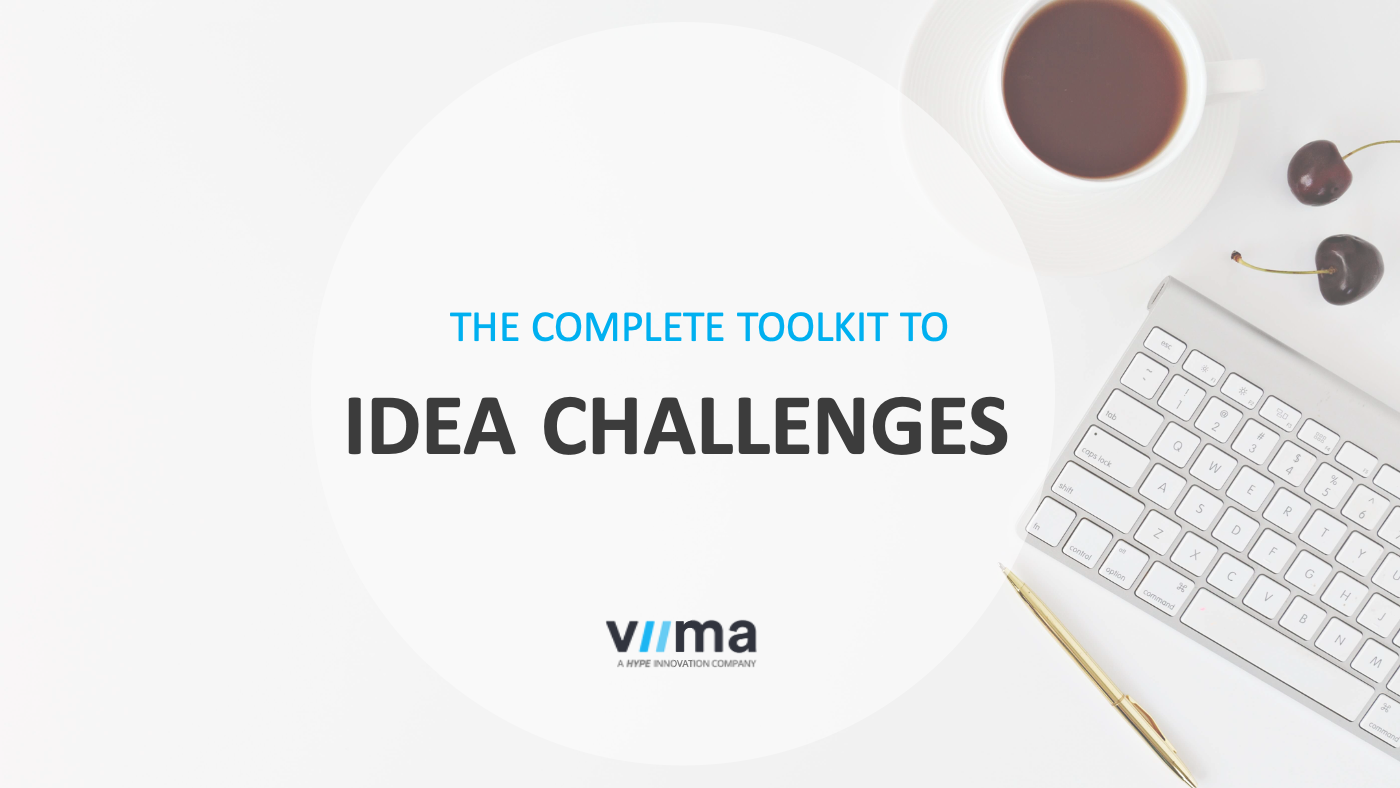
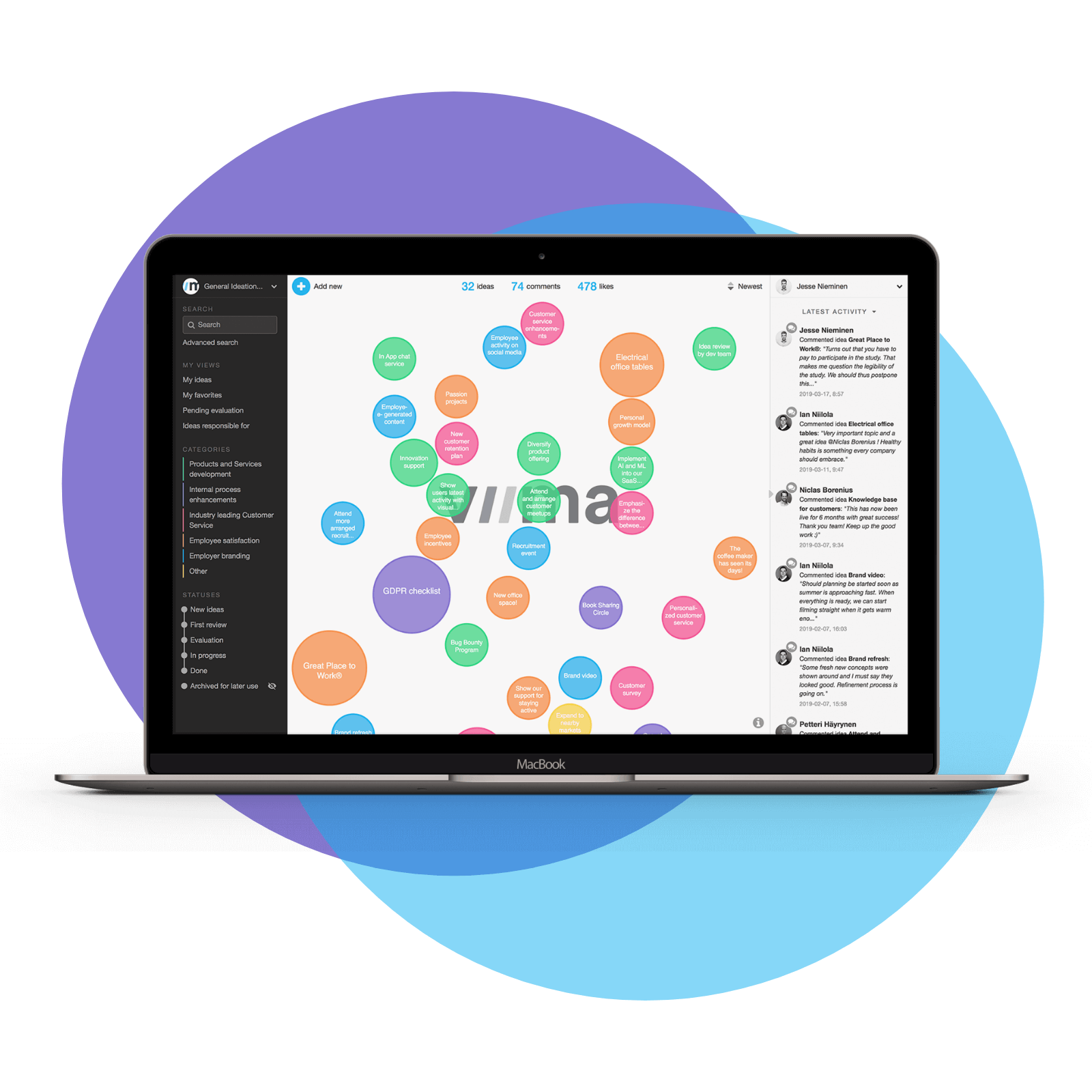




.png)
